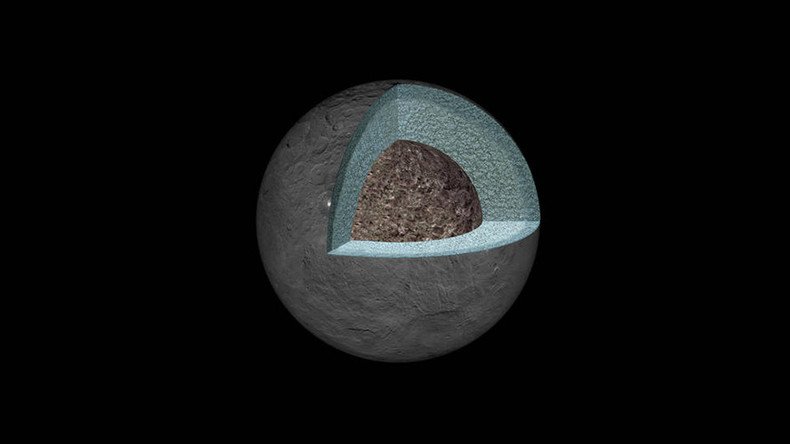Inside Ceres: Gravity study sheds new light on dwarf planet’s peculiar core

Scientists believe they have cracked the case of what lies beneath the surface of Ceres by mapping the gravitational field surrounding the Texas-sized dwarf planet.
Observations of one of the first asteroids to be discovered has resulted in a number of hypotheses regarding what makes up Ceres, including theories that its interior floats around as a homogeneous core.
But now a new study – using data collected by NASA’s Dawn spacecraft – suggests that inside Ceres has partially defined layers which consist of a rocky centre and zones of ice.
What's inside #Ceres? New insights from gravity study https://t.co/RxK1zdVyHwpic.twitter.com/QNBaKmgHAv
— NASA's Dawn Mission (@NASA_Dawn) August 3, 2016
The latest Ceres study is detailed in this month’s Nature journal and suggests that the dwarf planet has two layers: A core and an outer shell around 70-190 kilometers thick.
READ MORE: NASA unveils stunning images of bright craters on dwarf planet Ceres (PHOTOS)
While the space study did not bore beneath the surface of the 975 by 909 kilometer planet, researchers were able to approximate the most likely ingredients of Ceres’ inner workings by the way it rotates.
Ceres is also much less dense than earth with a weak interior that means its rotational spin dictates the dwarf planet’s shape, scientists say.
The low angle of sunlight creates stark shadows in this scene on #Cereshttps://t.co/jKc3rqycK2pic.twitter.com/o42scBy8G6
— NASA's Dawn Mission (@NASA_Dawn) August 2, 2016
“The new data suggest that Ceres has a weak interior, and that water and other light materials partially separated from rock during a heating phase early in its history,” said Ryan Park, the lead author of the study, told NASA.
“We have found that the divisions between different layers are less pronounced inside Ceres than the moon and other planets in our solar system,” he added.
Where have all the big craters gone on #Ceres? New study https://t.co/FLBk6E5tWqhttps://t.co/p5gQAEoMJF
— NASA's Dawn Mission (@NASA_Dawn) July 26, 2016
“Earth, with its metallic core, semi-fluid mantle and outer crust, has a more clearly defined structure than Ceres.”
Last month it was revealed that large craters thought to have once pock marked the surface of Ceres had seemingly disappeared.
While it’s not clear exactly how the planet “healed” the large impact craters, scientists believe its peculiar composition contributes to the unusual process.












